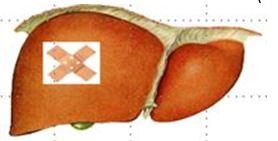
JRC scientists have used an Adverse Outcome Pathway approach to explain how some chemicals can potentially cause liver fibrosis in humans in order to support the development of non-animal approaches to chemical safety assessment.
Liver fibrosis is an important human health effect associated with chemical exposure and is thus an issue of regulatory concern. It results from chronic hepatic injury and may further lead to cirrhosis and liver cancer with considerable mortality. Animal models are currently used in regulatory testing for assessing potential target-organ toxicity of chemicals employed in a variety of sectors. However in vivo studies are undesirable due to ethical concerns and uncertainty in how predictive animal tests actually are of potential adverse effects in humans. Thus there is a strong impetuous to use mechanistic understanding of toxicological processes to inform the development of integrated approaches to testing and assessment of chemicals based on alternative methods such as in vitro assays and computer models.
The recent paper published by scientists at the JRC's EU Reference Laboratory for Alternatives to Animal Testing (EURL ECVAM) outlines the Adverse Outcome Pathway (AOP) between hepatic injury caused by protein alkylation and the onset of liver fibrosis. One application of this AOP knowledge is hoped to be the design of an in vitro testing strategy to screen chemicals for potential toxicological properties. The development of the fibrosis AOP followed the relevant OECD guidance and is also available in the new OECD Series on Adverse Outcome Pathways, along with other AOPs from the JRC related to aspects of neurotoxicity in adults and certain neurotoxicological effects that can be caused during human development.
The AOP framework provides a systematic approach for managing mechanistic knowledge of toxicological processes associated with potential effects of chemicals on human health and the environment. Moreover, systematically capturing knowledge as AOPs can efficiently direct the design and development of predictive toxicology approaches and guide the use of data derived from in vitro and in silico methods for toxicological hazard assessment. The JRC has also partnered with the OECD and the US Environmental Protection Agency to develop the publically accessible AOP Knowledge Base.
Read more in: T. Horvat, et al.: "Adverse outcome pathway development from protein alkylation to liver fibrosis" Arch Toxicol 91 (2017) 1523-1543, doi:10.1007/s00204-016-1814-8
Related Content
Adverse outcome pathway development from protein alkylation to liver fibrosis
Details
- Publication date
- 4 April 2017
